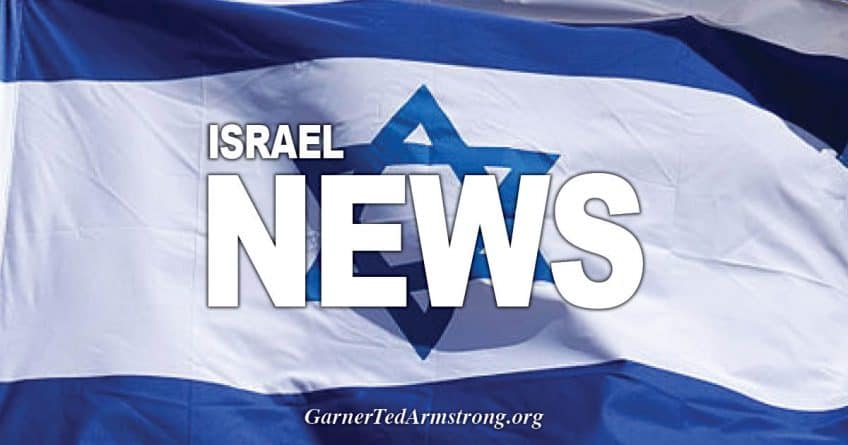The ongoing crisis between Hamas and the Palestinian Authority could lead Hamas’ chief to launch an offensive against Israel
Despite the renewed rocket and mortar fire from the Gaza Strip and growing criticism from the opposition, the government apparently doesn’t intend to alter its policy of relative restraint toward Gaza. This time, the army’s response will likely be harsher, but the goal, as dictated by the government, will still be to try to restore calm along the border.
Friday afternoon, three mortar shells were fired at the western Negev from Gaza, two of which were intercepted by the Iron Dome antimissile system. The mortars were fired during a memorial ceremony for Staff Sgt. Oron Shaul, who was killed during the 2014 Gaza war and whose body is still being held by Hamas. Participants in the ceremony, which took place outdoors at Kibbutz Kfar Aza, were filmed taking cover when the siren sounded. The images sparked renewed criticism of the government’s restrained response to the rocket fire.
On Friday, the army fired tank shells at Hamas positions along the border, and struck Hamas observation points in the southern Gaza Strip on Saturday night. But given the embarrassment these pictures caused the government, a harsher response will likely be approved this time.
Nevertheless, army officers stressed that the goals remain the same – restoring calm and maintaining it for as long as possible, to enable completion of the anti-tunnel barrier around Gaza and the detection of additional cross-border Palestinian attack tunnels.
Almost 40 rockets and mortars have been fired from Gaza since U.S. President Donald Trump recognized Jerusalem as Israel’s capital on December 6. About half of them landed in or near communities near the Gaza border, but none caused any casualties.
Defense Minister Avigdor Lieberman said in an interview with Israel Television News Saturday night that Friday’s mortars were made in Iran and were identical to those fired at an army outpost on the Gaza border by Islamic Jihad on November 30. Iran is Islamic Jihad’s principal financier, and also recently increased its financial aid to Hamas’ military wing.
Radical Salafi groups have been responsible for most of the recent rocket and mortar fire. The defense establishment says Hamas continues to try to stop these groups from shooting and has arrested dozens of their members. But it also continues to organize stormy demonstrations along the Gaza border every weekend. During Friday’s demonstration, Israeli soldiers killed one Palestinian and wounded dozens.
In Israel’s view, the main risk of escalation is not the rocket fire, but Gaza’s worsening humanitarian situation and the impasse in the reconciliation talks between Hamas and the Palestinian Authority. In recent weeks, the number of trucks carrying merchandise into Gaza has fallen to around 530 per day from a peak of almost 1,000. In the final quarter of 2017, the amount of merchandise entering Gaza was down around 20 percent from the same period last year, due mainly to the decline in Gazans’ purchasing power as a result of the worsening economic situation.
Hamas opted to reconcile with the PA because of these economic woes, especially its inability to pay salaries to government employees in Gaza and buy fuel for Gaza’s power plant. But the reconciliation agreement, reached through Egyptian mediation, is being implemented very slowly. The PA has assumed control of Gaza’s border crossings with Israel and is now even present at the Rafah border crossing with Egypt, but Egypt continues to keep the crossing closed most of the time.
The PA hasn’t yet transferred any funds to Gaza, nor has it taken over the management of government offices in Gaza as agreed upon in the deal. Gaza’s water quality is deteriorating, its sewage still flows into the sea and the stench from drainage basins in northern Gaza is getting worse. Now that winter is here, the ongoing electricity shortage will make Gazans’ lives even more miserable, and the water and sewage problems may lead to outbreaks of infectious disease.
The reconciliation deal’s main stumbling block is the dispute over Hamas’ military wing. PA President Mahmoud Abbas fears Hamas will follow the model of Hezbollah in Lebanon – retaining its independent military capabilities, and therefore also its political influence. Consequently, he has conditioned progress in implementing the reconciliation agreement on Hamas subordinating its military wing to the PA. Hamas’ leader in Gaza, Yahya Sinwar, adamantly refuses.
If the Hamas-PA crisis continues, it could lead Sinwar to launch an offensive against Israel, something Hamas hasn’t done since the end of the 2014 war.
Israel is worried about Iran’s growing influence over Hamas. For several years Hamas’ leadership was reluctant to get too close to Iran because of Tehran’s upport for theAssad regime, which slaughtered members of the Muslim Brotherhood, Hamas’ parent movement. But the money Iran has been sending to Gaza, through Gazan banks and couriers, helps to pay the salaries of members of Hamas’ military wing and to produce weapons. A few weeks ago, senior Hamas official Saleh al-Arouri visited Tehran immediately after attending the reconciliation talks with the PA in Egypt.
Source: https://www.haaretz.com/middle-east-news/palestinians/.premium-1.832082
[Disclaimer]







